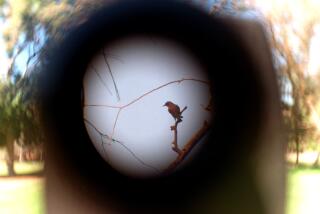OUTDOORS : Birds Wing It With a Little Place in the ‘Burbs
- Share via
Some Orange County birds live here year-round, and some are just passing through. Local residents of the human variety can provide food and shelter to both with little effort and expense.
Showing a bit of hospitality can pay off by turning ordinary suburban yards into mini-wildlife sanctuaries. And this is a good time of year to try it out--migratory birds not seen in these parts at other times of the year come in winter.
Devoted bird-watchers and novices alike will find it a relatively simple task to make their yards user-friendly. All it takes is a place for the visitors to eat, drink and catch a good night’s sleep--sort of like an avian Howard Johnson’s. In addition to the migratory birds, locals will also take advantage of the offerings and visit often.
Putting up even the most rudimentary bird feeders and baths will draw visitors. Birdhouses are less likely to have residents but can be hung for aesthetic purposes to enhance gardens.
Birds just seem to prefer to nest in natural dwellings and are only likely to inhabit a human-made birdhouse if it is near the foothills or if the yard backs up to one of the county’s wilderness parks, according to Dick Purvis with the Sea & Sage Chapter of the Audubon Society.
“I’ve had a nesting box in my yard for 15 years and have never had a bird use it,” Purvis said.
The handcrafted nesting boxes he supplies to the Audubon Society do attract nesting birds, but they are always in wilderness areas or parklands. Audubon has a program to try to replace nesting sites for birds in an effort to maintain the county’s bird populations even as habitat is dwindling from development.
“We’re trying to attract bluebirds right now, and we have about 100 nest boxes in the county and about 75 pair of nesting bluebirds,” Purvis said.
Purvis’ nesting boxes--the preferred term for birdhouses--are made of scrap pine about an inch thick. The shape of a nesting box is not as important as the size of the entrance hole. It must be big enough only for the species of bird it is being set out for and too small for other birds who may prey on eggs.
For instance, a box measuring four inches wide, four inches deep and eight inches high with a 1 1/2-inch in diameter entrance hole will accommodate ash-throated flycatchers, house wrens, plain titmice and house sparrows. But it is too small for European starlings, which displace many domestic species.
FEEDERS
Placing feeders in a yard is probably the best way to attract birds. You can even influence the type of birds you attract by the type of feeder and food used.
There are a few standard types of feeders. Vertical tube feeders are made of clear plastic with perches and feeding portals along the length; they are seed feeders and usually attract smaller birds such as chickadees. Shelf feeders can be as simple as a platform nailed to a post or as elaborate as those made with storage hoppers that automatically spill more food onto the shelf as it is eaten.
Bird tables provide feeding opportunities for birds that cannot cope with hanging feeders. There is usually a rim that prevents food from falling off and a roof to protect against rain. These type of feeders will attract sparrows, spotted doves and mourning doves. There can also be wire mesh surrounding the table to allow smaller birds in but keep larger ones out.
Covers on table feeders need to be at least 30 inches in diameter so that when it rains, the water rolls off, leaving the food dry, according to Purvis.
All feeders should be at least five feet off the ground to keep cats from jumping up and partaking in a little feeding of their own.
The type of food put out for birds is as important as the design of feeders. The most universally attractive food is sunflower seed, especially the small all-black variety known as oil sunflower. According to “The Practical Ornithologist” (Simon & Schuster, 1990) white or red porso millet is favored by mourning doves and most sparrows.
If you want to attract hummingbirds, it is necessary to hang a bottle feeder filled with sugar water, preferably one with the glass or feeding spigot colored red or orange. Hummingbirds are attracted to the bright color (do not color the water with food dye and do not use honey to sweeten it).
Hummingbird feeders should be sterilized periodically with hot water to keep fungus out, said Doug Willick, consulting biologist with P & D Technologies in Orange.
But hummingbirds need some protein for a balanced diet, said Ray Munson, manager of Tucker Wildlife Sanctuary in Modjeska Canyon. “They can’t live by eating just that sugar water stuff. Their teeth would fall out,” he joked.
Fruit flies provide the protein most favored by hummingbirds. Leaving a banana peel near the feeder will attract the flies and the birds.
Placement of the feeders is also important. There should be plenty of brush nearby so birds can hide from predators. It’s also a good idea to have feeders over grass so bird droppings do not become a nuisance on patios.
BATHS
Don’t think that just because it’s not summer, birds no longer need a cool respite. Bathing in winter helps birds insulate against the cold by keeping their feathers clean, allowing for air to get trapped between them.
Birdbaths can be an eye-catching addition to a back-yard garden, provided they are kept clean and algae-free.
Baths need to be shallow but with plenty of room for splashing. Most birds bathe by wading in water no deeper than their legs. Two or three inches is usually sufficient. Sides of the bath should slope gently; some birds have trouble judging a bath’s depth if the sides are too vertically sharp. Placing a flat rock in the center will give them an island to stand on.
A bath of 24 to 36 inches in diameter will allow for more than one bather at a time.
“Around here baths should work well in attracting birds because it’s relatively dry,” Willick said. “Once they find they have a regular source, they’ll keep coming back.”
The best way to keep a bath clean is to change the water regularly and scour the bottom when necessary.
The only drawback to baths is that they tend to be a magnet for cats ready to pounce on unsuspecting bathers. The best ways to guard against this are to not have a cat or put a bell around its neck.


